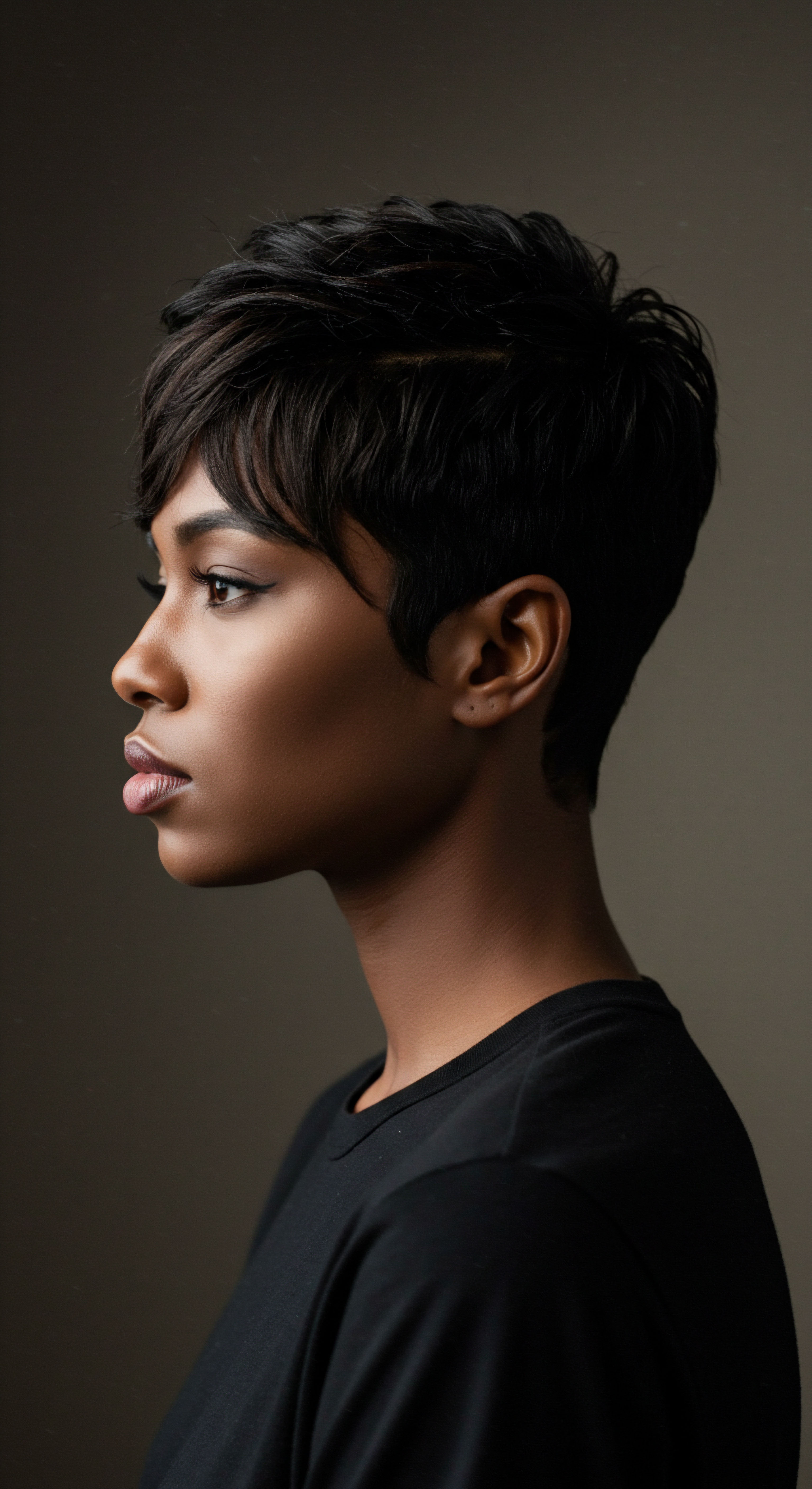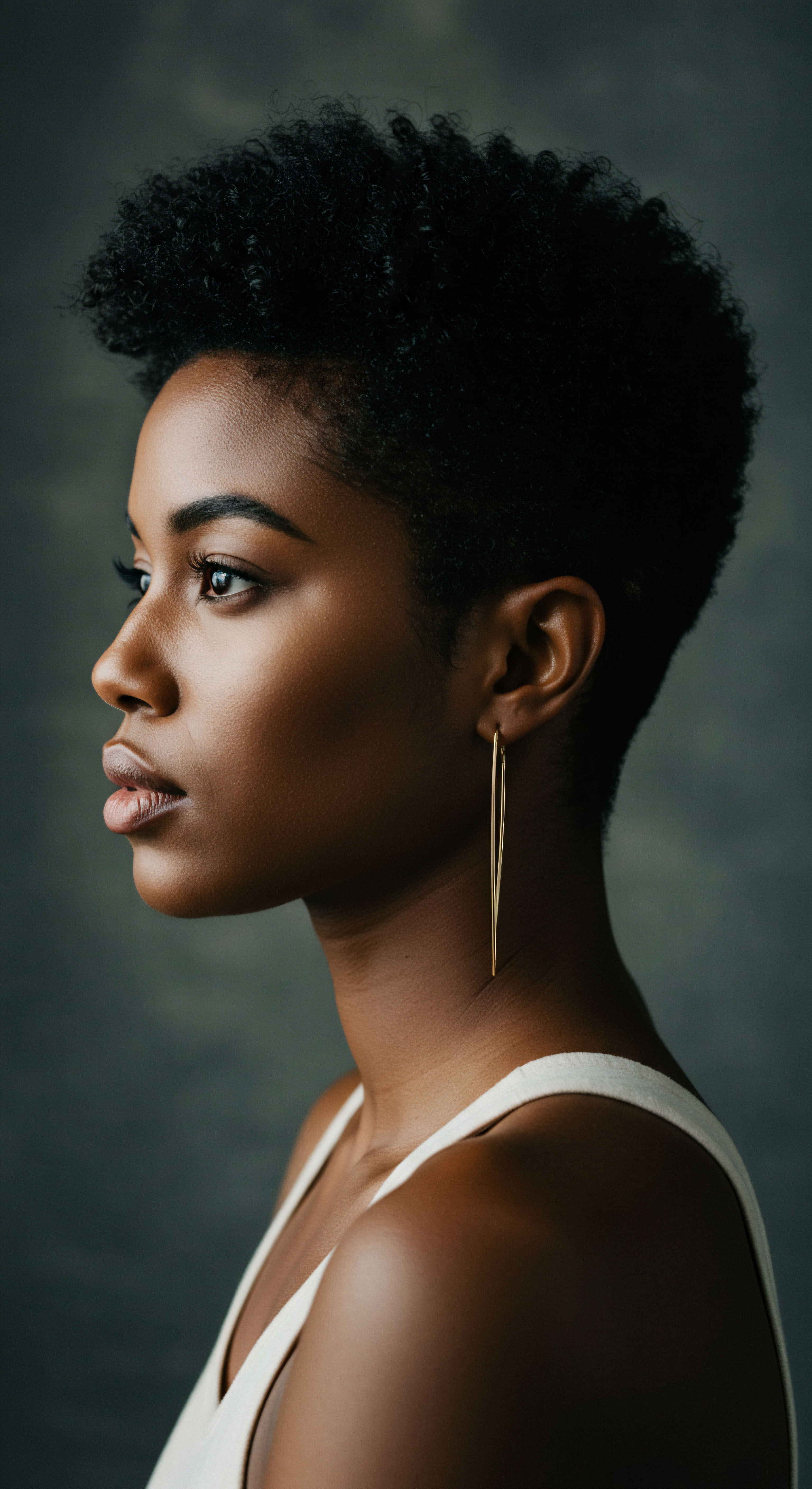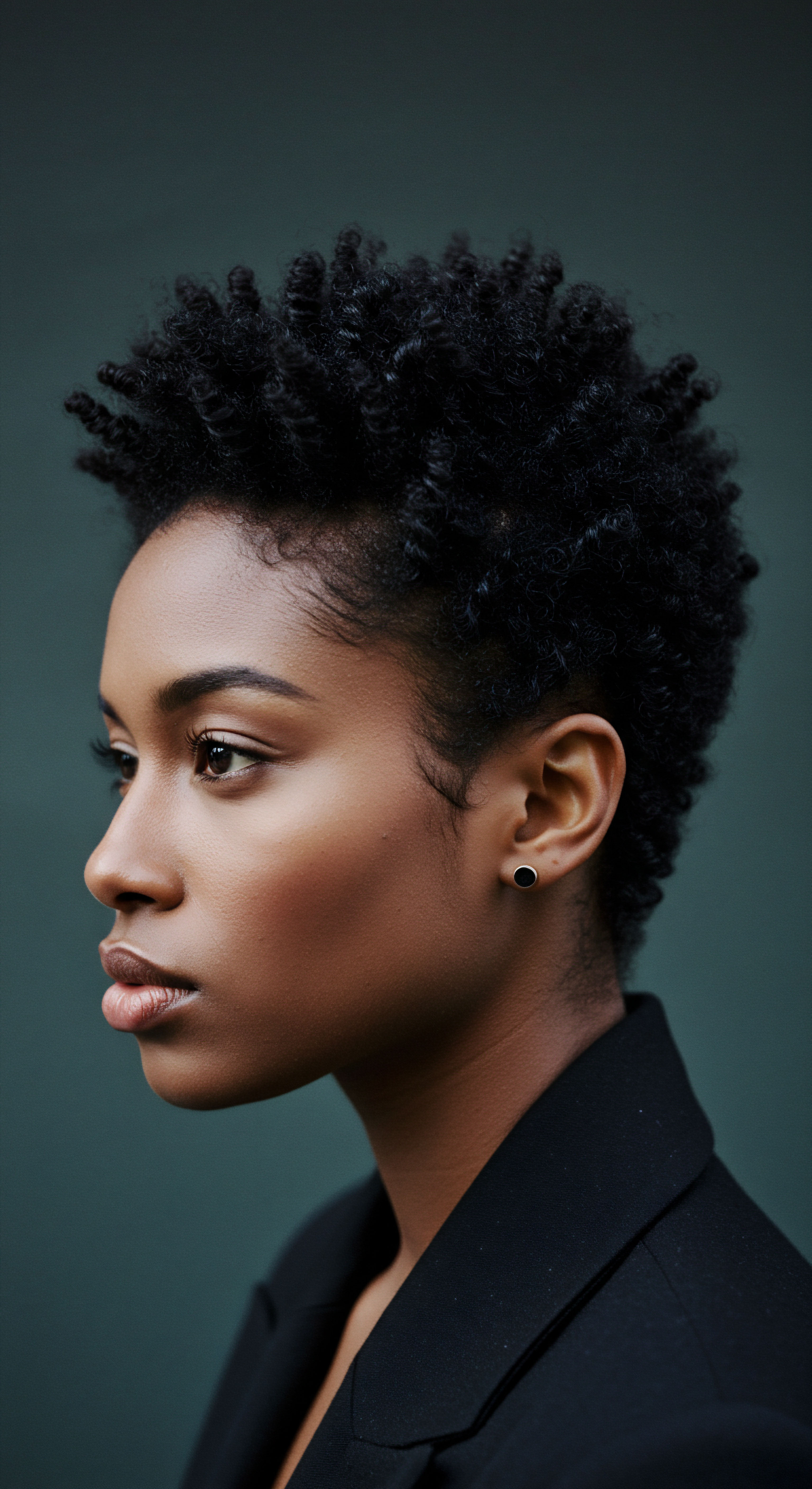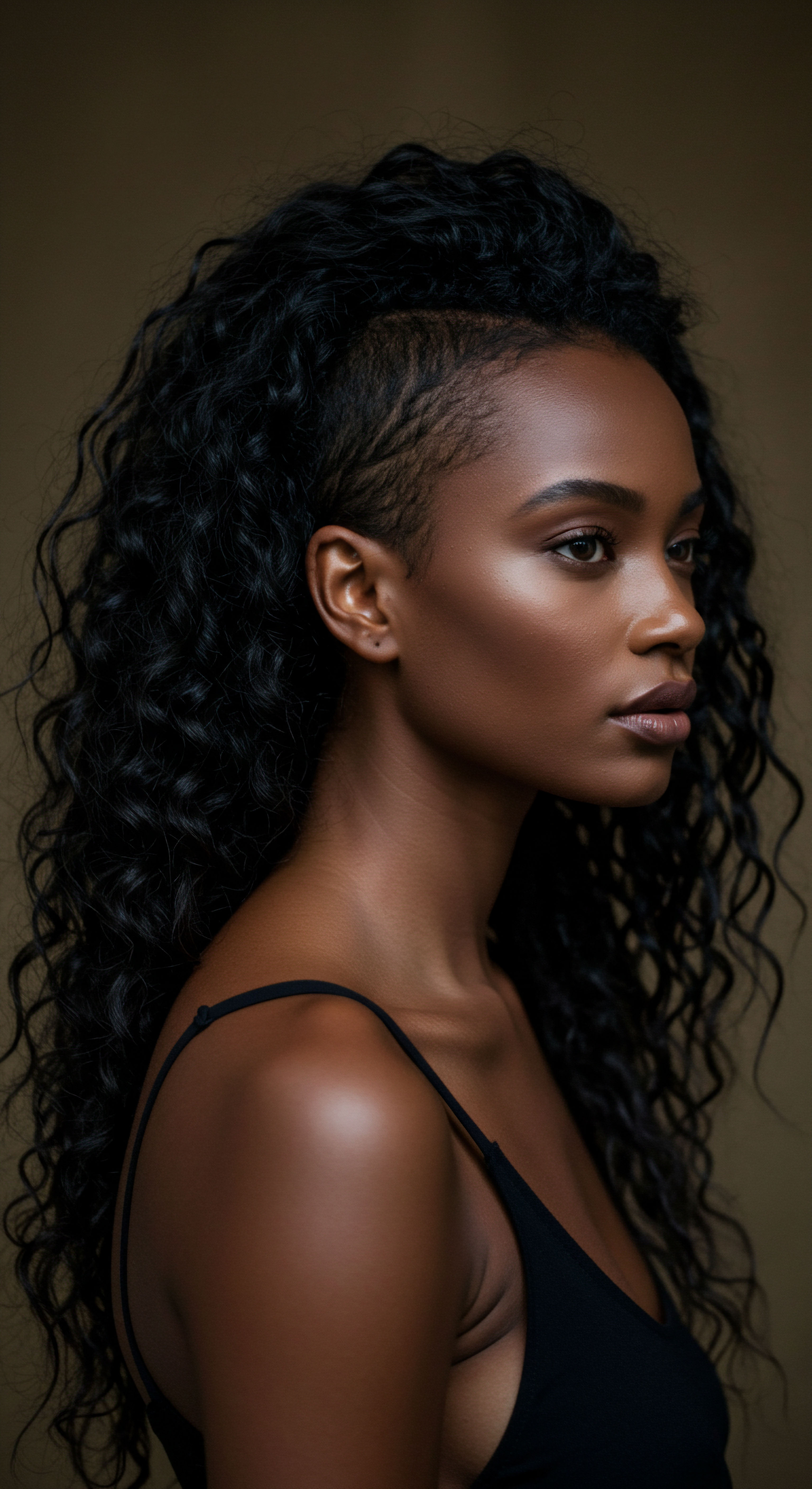
Roots
The conversation surrounding hair breakage often begins with a whisper of frustration, a silent sigh over scattered strands. Yet, to truly comprehend how gentle care might mitigate this common concern, we must first descend to the very foundations of the hair itself. A single strand, seemingly delicate, conceals an architectural marvel, a testament to biological design. Understanding this inherent structure, particularly for textured hair, illuminates why it responds so uniquely to external forces and why a tender touch becomes a profound act of preservation.
Textured hair, with its remarkable diversity of curls, coils, and kinks, possesses distinct characteristics that set it apart from straighter hair types. At a microscopic level, the hair shaft of curly hair often exhibits an elliptical or flattened cross-section, rather than the round shape typical of straight hair. This unique geometry, coupled with varying degrees of twists and turns along the strand, contributes to points of inherent fragility.
Where the hair bends and turns, the cuticle, the outermost protective layer composed of overlapping scales, can be naturally lifted or unevenly laid. This structural variance renders textured hair more susceptible to external aggressors and moisture loss.
Consider the hair’s primary component ❉ Keratin, a protein that forms the core of each strand. This robust protein provides strength and elasticity. However, daily interactions, environmental exposures, and styling practices can deplete these essential proteins, leaving hair vulnerable.
The integrity of the cuticle is paramount; when its scales lie flat, they create a smooth surface that reflects light and seals in moisture. When disturbed, either through mechanical friction or chemical processes, these scales can lift, allowing moisture to escape and exposing the inner cortex to damage.
A hair strand, particularly one with texture, holds a complex biological story, with its shape and composition dictating its vulnerability and strength.

How Does Hair Morphology Influence Breakage Susceptibility?
The intricate morphology of textured hair directly influences its susceptibility to breakage. Studies indicate that as the degree of curliness increases, the hair’s break stress decreases. This suggests that the very curls and twists, while beautiful, create localized stress concentrations and points of weakness when the hair is stretched.
For instance, Afro-textured hair, known for its tight curls, has been observed to break roughly ten times faster than straighter Caucasian hair under certain shear stresses, such as those experienced during combing or brushing. This inherent predisposition underscores the importance of gentle handling.
The cuticle layers in highly coiled or kinky hair types can be fewer compared to other hair types, making them inherently more prone to damage and brittleness. This diminished protective barrier means that external forces have a more direct impact on the internal structure. When these delicate strands are dry, the friction between them can be amplified, leading to tangles and knots that, when pulled or forced, result in fracture.

What are the Building Blocks of Hair Health?
The foundation of resilient hair rests upon several key elements, both internal and external. Internally, the balance of protein and moisture within the hair shaft is critical. Hair requires adequate protein for strength and structure, while sufficient moisture provides flexibility and prevents brittleness. A healthy equilibrium ensures the hair is both strong and supple, capable of withstanding daily manipulation.
- Keratin ❉ The primary protein making up about 90% of the hair’s structure, providing strength and resilience.
- Cuticle ❉ The outermost protective layer, a series of overlapping scales that shield the inner cortex from damage and regulate moisture.
- Cortex ❉ The central, thickest layer of the hair shaft, containing melanin (pigment) and contributing significantly to the hair’s mechanical properties.
External factors also play a substantial role. The environment, including exposure to UV radiation and pollutants, can degrade hair proteins and lipids, increasing surface friction and reducing tensile strength. Even the water used for washing can influence hair health; hard water, with its high mineral content, can leave deposits that make hair rough, dull, and prone to breakage. Understanding these fundamental aspects allows for a more informed and gentle approach to hair care, moving beyond surface-level solutions to address the hair’s true needs.

Ritual
Stepping beyond the fundamental science of hair, we arrive at the daily and weekly practices that shape its vitality. The act of caring for textured hair transcends mere routine; it transforms into a deliberate ritual, a series of thoughtful movements and applications designed to honor its delicate nature. This approach, centered on gentleness, acknowledges that every touch, every product choice, every styling decision holds the potential to either preserve or compromise the hair’s integrity. It is within these consistent, mindful actions that the true power to reduce breakage resides.
The traditional wisdom passed down through generations often highlights the importance of protective measures, a sentiment now echoed by modern science. Ancient civilizations, from Egypt to India, employed natural oils and herbs not only for their cosmetic appeal but for their nourishing and protective qualities, shielding hair from environmental stressors and maintaining its strength. This historical understanding of preservation provides a rich context for today’s gentle care rituals.

Does the Method of Detangling Affect Hair Breakage?
One of the most significant contributors to hair breakage, particularly for textured hair, is improper detangling. The tight curl patterns are prone to forming knots and tangles, and forcing a comb through dry, matted hair can lead to significant mechanical damage. Research suggests that textured hair is more prone to premature fracturing, breaking under low levels of stretching, and this fracturing is reduced when the hair is stretched while wet.
A gentle detangling ritual often involves applying a conditioner or a detangling product to lubricate the hair strands, reducing friction. The American Academy of Dermatology recommends that those with textured hair or tight curls always comb their hair while it is damp, using a wide-tooth comb. The process should begin at the ends of the hair, slowly working upwards in small sections, rather than pulling from the roots. This method minimizes tension on the scalp and prevents breakage by allowing knots to be unraveled rather than ripped through.
Mindful detangling, beginning at the ends and using a wide-tooth comb on damp, conditioned hair, is a quiet revolution against breakage.

How Do Cleansing and Conditioning Practices Impact Hair Health?
The act of cleansing and conditioning forms the core of any hair care ritual. For textured hair, which is naturally more prone to dryness due to the difficulty of natural oils traveling along the coiled strands, these steps are crucial for moisture retention.
- Cleansing with Care ❉ Instead of vigorously rubbing shampoo into the entire length of the hair, gently massage it into the scalp. Allow the rinse to flow through the hair’s length, cleansing it without causing unnecessary friction. Some hair care philosophies even suggest reducing the frequency of washes or opting for co-washing (washing with conditioner) to prevent dryness, particularly for those with very dry or thick hair.
- Conditioning for Resilience ❉ Conditioner is a vital shield against damage. It helps to decrease friction, detangle the hair, and improve combability by neutralizing negative charges on the hair fiber and lubricating the cuticle. After every shampoo, a conditioner should be applied, focusing on the mid-lengths and ends. For an extra layer of protection, a leave-in conditioner can provide continuous moisture and a barrier against environmental stressors.
The choice of products also holds weight. Ingredients that promote a healthy protein and moisture balance are beneficial. While protein treatments can fortify the hair shaft and improve elasticity, over-application can lead to stiffness. A balanced approach, recognizing the hair’s specific needs, is key.

What Role Do Low Manipulation Styles Play in Reducing Breakage?
The constant handling and styling of hair can exert significant mechanical stress, leading to breakage over time. Low manipulation styles, which require minimal handling and maintenance, offer a powerful strategy for length retention and overall hair health. These styles reduce the frequency of combing, brushing, and stretching, thereby minimizing the internal shear forces that can lead to crack formation in the hair shaft.
Protective styles, a subset of low manipulation approaches, involve tucking away the fragile ends of the hair, shielding them from environmental exposure and mechanical friction.
| Style Category Braids |
| Description and Benefit Single braids, cornrows, or box braids minimize tangling and protect ends from environmental stressors. They reduce the need for daily styling. |
| Style Category Twists |
| Description and Benefit Two-strand twists or flat twists help retain moisture and reduce manipulation, similar to braids. |
| Style Category Buns and Updos |
| Description and Benefit Securing hair in a loose bun or updo minimizes friction against clothing and surfaces, reducing breakage, particularly for longer hair. |
| Style Category Pineapple Puff |
| Description and Benefit Gathering hair loosely at the crown reduces friction during sleep and preserves curl definition. |
| Style Category These styles offer a way to preserve hair length by limiting daily manipulation and environmental exposure. |
While protective styles do not directly accelerate hair growth, they create an optimal environment for hair to reach its full growth potential by minimizing breakage. This approach celebrates the hair’s natural form, allowing it to rest and flourish without constant interference.

Relay
Moving beyond the foundational elements and daily practices, we encounter the deeper, often unseen influences that impact hair resilience. The story of hair breakage is not a simple tale of mishandling; it is a complex interplay of internal predispositions, environmental dialogues, and the subtle yet profound impact of our habits. This section aims to unravel these layers, connecting the dots between scientific observations, cultural wisdom, and the practical implications for truly robust hair health. We seek to understand not just what happens, but the intricate ‘why’ behind the hair’s response to gentle care.
Consider the subtle, pervasive forces that hair encounters daily. Beyond direct manipulation, environmental factors like UV radiation and air pollution inflict oxidative damage, compromising the hair’s protein structure and surface quality. Even the water we use for cleansing carries a hidden narrative for our strands.
The presence of minerals, particularly calcium and magnesium, in hard water can cause hair cuticles to lift, increasing porosity and rendering the hair more susceptible to damage and breakage. This environmental dialogue underscores the need for a holistic perspective on hair care.

What are the Overlooked Environmental Factors Affecting Hair Strength?
While heat styling and chemical treatments are well-known culprits of hair damage, environmental factors often receive less attention despite their significant impact. The very air we breathe and the water we wash with can silently contribute to hair fragility.
- Hard Water Exposure ❉ Research indicates that hard water, rich in calcium and magnesium ions, can deposit minerals onto the hair shaft. This mineral buildup creates a film, hindering moisture penetration and making hair feel rough, dull, and more difficult to manage. A study from 2016 involving 15 females found that hair washed in hard water for 30 days showed decreased thickness and a ruffled appearance. Another study on 70 males found hair lost strength when exposed to hard water, leading to breakage. This rigidity compromises hair elasticity, making it more prone to breakage and split ends.
- UV Radiation and Pollution ❉ Sunlight, particularly UV radiation, can break down hair’s protein structure, leading to weakened strands. Air pollutants, such as particulate matter and polyaromatic hydrocarbons, can settle on the scalp and hair, causing oxidative stress and damaging hair follicles and the hair shaft. This cumulative environmental stress reduces the hair’s natural defenses, making it more vulnerable to mechanical breakage.
These factors highlight that gentle care extends beyond how we touch our hair; it encompasses understanding and mitigating the external forces that constantly challenge its integrity. Incorporating water filters or chelating shampoos, and using UV-protective hair products, can become extensions of a gentle care philosophy.

How Does Sleep Protection Influence Hair Longevity?
The hours spent in slumber, seemingly a period of rest, can paradoxically be a time of significant mechanical stress for hair. Tossing and turning on certain fabrics can create considerable friction, leading to tangles, frizz, and ultimately, breakage.
A compelling example of the impact of sleep protection comes from anecdotal and emerging research. Dr. Alicia Mendez, a trichologist at the Austin Hair Research Center, notes that switching to silk or satin materials for pillowcases or caps can reduce friction by up to 43% during sleep.
She observed a client, Emma, who experienced severe breakage, saw remarkable improvement after just two weeks of using a satin cap, with reduced morning frizz and improved moisture retention. This suggests that even subtle, consistent friction can contribute significantly to breakage over time, and mitigating it offers tangible benefits.
| Strategy Silk or Satin Pillowcases |
| Mechanism of Protection These smooth fabrics reduce friction between hair and the sleeping surface, preventing tangles, frizz, and mechanical damage. |
| Strategy Silk or Satin Bonnets/Scarves |
| Mechanism of Protection Similar to pillowcases, these head coverings create a protective cocoon for the hair, shielding it from friction and preserving moisture. |
| Strategy Loose Hairstyles |
| Mechanism of Protection Securing hair in loose braids, buns, or a "pineapple" at the crown minimizes tangling and tension on the scalp, preventing breakage from movement during sleep. |
| Strategy Avoiding Wet Hair |
| Mechanism of Protection Hair is weakest when wet. Sleeping with damp hair increases its susceptibility to breakage and matting due to friction. |
| Strategy Implementing these practices can significantly reduce breakage by minimizing mechanical stress during sleep. |
These seemingly small adjustments to nighttime rituals represent a powerful form of gentle care, preserving the hair’s structural integrity over the long term. They underscore that protection is not only about what we apply to our hair, but also about the environment we create for it, even while we rest.

How Does Understanding Protein and Moisture Balance Inform Gentle Care?
The concept of protein and moisture balance is a frequent topic in hair care discussions, and its scientific basis provides a deeper understanding of how hair responds to treatments. Hair, primarily composed of protein, requires a delicate equilibrium of both protein and hydration to maintain its strength and flexibility.
When hair lacks sufficient protein, it can become weak, limp, and overly stretchy, leading to increased breakage. Conversely, hair that is over-moisturized without adequate protein can feel mushy or overly soft, also making it prone to damage. This phenomenon, sometimes called hygral fatigue, refers to the weakening of hair from repeated swelling and shrinking due to water absorption and drying, leading to protein loss.
For textured hair, which can be naturally more porous and susceptible to moisture fluctuations, achieving this balance is particularly pertinent. Porosity, the hair’s ability to absorb and retain moisture, varies among individuals and even along a single strand. Hair with high porosity, where cuticle scales are more open, tends to absorb water quickly but also loses it rapidly, making it feel dry and brittle. Low porosity hair, with tightly closed cuticles, resists water absorption but can experience product buildup.
Understanding your hair’s porosity guides the selection of products and the frequency of protein or moisturizing treatments. Gentle care, in this context, involves a thoughtful calibration ❉ providing protein to fortify weakened strands and moisture to maintain elasticity, without overdoing either. This nuanced approach prevents the extremes that can lead to breakage, allowing hair to maintain its inherent strength and supple quality.

Reflection
The quiet commitment to gentle care for textured hair is more than a fleeting trend; it is a profound recognition of its unique architecture and enduring spirit. From the microscopic undulations of each strand to the grand narratives of cultural traditions, we observe a consistent truth ❉ reverence for the hair’s intrinsic nature is the most potent shield against breakage. This journey through anatomy, ritual, and environmental dialogue reveals that every tender touch, every informed choice, contributes to a resilient and radiant crown. The practice of gentle care is not merely about preventing loss, but about honoring the vitality and beauty that resides within each coil, kink, and curl.

References
- Exploring the Use of Natural Ingredients for the Protection of Textured Hair from Ultraviolet Radiation ❉ An In Vitro Study. MDPI.
- Rediscovering Historical Hair Care Practices. Fabulive.
- Tresses Through Time ❉ A Journey Through the History of Hair Care. Ruwaa Life.
- Does Hard Water Cause Hair Loss? A Science-Backed Answer. Wimpole Clinic.
- Damaged Hair ❉ What Is It, How does it Happen and Why Afro Textured Hair Is Prone to It.
- The History of Haircare ❉ How Past Practices Shape Modern Routines. Kenra Professional.
- Defying Damage ❉ Understanding Breakage in Afro-textured Hair. Cosmetics & Toiletries.
- Hair fiber characteristics and methods to evaluate hair physical and mechanical properties. SciELO.
- Hair fiber characteristics and methods to evaluate hair physical and mechanical properties.
- Environmental and cosmetic factors in hair loss and destruction. Curr Probl Dermatol.
- How to Treat and Prevent Hard Water Hair Damage. Healthline.
- Any science behind hard water/calcium changing hair texture, causing breakage? Reddit.
- I stopped using cotton pillowcases and reduced hair breakage by 43% (what my hairstylist noticed after 2 weeks).
- Calcium Hair Damage & Buildup – Hard Water Effects. Fabio Scalia.
- Healthy Hair – Protein And Moisture Balance. Absolutely Everything Curly.
- Hair Care. National Museum of American History.
- Science of Curly Hair. Redken.
- Volume 72 Special Edition page 730. JOURNAL OF COSMETIC SCIENCE.
- Hair Care through the ages ❉ Inspired by the past, Designed for the future. Safic-Alcan.
- Hair Moisturization Claims 101. TRI Princeton.
- How To Protect Your Hair At Night .
- THE STRUCTURE OF YOUR HAIR. My Hair Doctor.
- Protective Styling For Afro-Textured Hair. Fulham Scalp And Hair Clinic.
- Systems Approach to Human Hair Fibers ❉ Interdependence Between Physical, Mechanical, Biochemical and Geometric Properties of Natural Healthy Hair. PMC.
- Low Manipulation Styles ❉ Everything You Need To Know. Livara Natural Organics.
- Detangle Without Damage. Earthtones Naturals.
- How to stop damaging your hair. American Academy of Dermatology.
- Stress-Free Styling ❉ Protective Hairstyles That Promote Growth & Health. Afrocenchix.
- All-day hair manageability for textured hair types – A revision of the current anti-frizz technologies and suggestions for the future.
- Impact of Environmental Stressors on Hair. NYSCC.
- Science Behind Protein Hair Treatments ❉ Are They Worth It? Needs Hair Studio.
- How to prevent breakage/weak hair ❉ r/HaircareScience. Reddit.
- ANALYSIS AND QUANTIFICATION OF HAIR DAMAGE ❉ PROGRESS REPORT NO. 32.
- Penetration of Vegetable Oils into Textured Hair Fibers ❉ Integrating Molecular Matrix Assisted Laser Desorption Ioni-Zation Time-of-Flight Mass Spectroscopy (MALDI TOF/TOF MS) Analysis with Mechanical Measurements. MDPI.
- The Effects of Environmental Pollutants and Exposures on Hair Follicle Pathophysiology.
- . ResearchGate.
- Environmental Factors and Hair Loss ❉ How Your Surroundings Affect Your Hair.
- Techniques Used for Hair Style Maintenance while Sleeping May Be a Risk Factor for Traction Alopecia. PMC.
- Improving the Mechanical Properties of Damaged Hair Using Low-Molecular Weight Hyaluronate. MDPI.
- How To BALANCE Protein & Moisture for Strong & Healthy Hair. YouTube.
- Scanning electron microscopy study of hair shaft changes related to hardness of water.
- What Happens When You Stop OVER MANIPULATING Your Natural Hair For 30 Days?
- Curly girl method ❉ Steps, benefits, and drawbacks. Medical News Today.
- How to Sleep with Long Hair to Protect the Health of Your Hair. Healthline.
- Caring for Afro-textured hair. British Association of Dermatologists.
- Low Manipulation and Protective Styling. Ecoslay.
- Experts Talk Caring for Damaged Curly Hair. DevaCurl.
- Hair Cosmetics ❉ An Overview. PMC.
- Understanding the Importance of Protein/Moisture Balance in Hair Care. Ziger Naturals.
- Is it possible for hair to need both more protein and more moisture? Reddit.